Top News

February 14, 2012. Photograph by Yasuhide Matayoshi of the Ryukyu Shimpo
U.S. military personnel were seen training with firearms at around 3:30pm on February 13 at a location near the Camp Kinser perimeter fence beside Route 58 in Nakanishi, Urasoe.
Passersby looking through the fence became concerned when they saw soldiers lying down holding rifles.
About 40 personnel were involved in the training and although many of them were pointing their rifles in the opposite direction from Route 58, some of the soldiers were seen to point their weapons parallel to the road. Some of them raised their rifles in the firing position as close as six meters from the fence but it is unclear as to whether or not the weapons were loaded. The personnel involved completed this drill before 4:00pm.
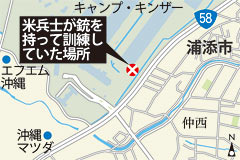
The spot where soldiers were seen training with rifles.
There is a residential area directly across the road from Camp Kinser. An Urasoe Municipal Office staff member asked Camp authorities about the drill after receiving reports from residents, and Camp Kinser staff responded that this was a routine training exercise that had begun the previous week. They explained that they had instructed the soldiers not to point their weapons towards the fence and that they are in the process of confirming the details of how the drill was carried out.
Marine Corps personnel in Camp Kinser were seen pointing rifles toward the road during a training exercise in 2005.
(English translation by T&CT, Mark Ealey)
Go To Japanese

Go To Video
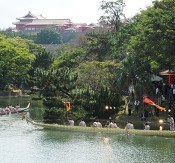
February 13, 2012 Ryukyu Shimpo
On February 12, the funa-asobi banquet of the style of the Ryukyu Dynasty was reenacted at Shuri Castle in Naha. Many people enjoyed listening to court music and dragon boat songs from all over Okinawa while watching boats on Ryutan Pond in Shurijo Castle Park. About 300 years ago, this type of banquet would have been held to welcome an envoy from China. On this occasion, the Tomigusuku Dragon Boat Association and the Shurijo Castle Park Management Center cooperated to reenact the event.
Members of local dragon boat groups from Naha, Itoman, Ishigaki and Tomigusuku performed their boat songs. First-year students from Tomigusuku Junior High School and Nagamine Junior High School wearing traditional clothing known as basajin paddled two dragon boats on the pond.
Nagamine Junior High School student Rintaro Miyazato said, “Paddling the boat was hard work, but I got to know a little about the history of exchange between Ryukyu and China. It was good.”
(English translation by T&CT, Mark Ealey)
Go To Japanese

Go To Video

February 10, 2012 Ryukyu Shimpo
On February 9, the first charter flight of Thai Airways International, the biggest airline company in Thailand, brought 245 Thai tourists from Bangkok to Naha. A welcome ceremony was held at the international terminal and Miss Okinawa presented the tourists with a bouquet. During their six-day trip they will visit Shuri Castle and the Okinawa Churaumi Aquarium.
The tour is an interactive charter tour planned by Jumbo Tours in Naha and on February 9, 187 tourists also departed from Okinawa for Thailand. The company plans to arrange a charter tour again to coincide with the Naha Festival in October.
The airline’s Area General Manager for Japan, Wiwat Piyawiroj, said, “Okinawa is a unique tourist destination in Japan. I hope that we can establish a good relationship through this charter flight.” With regard to the possibility of regular flights, he said, “That is something that we really do want to look at in future.” Frequent visitors to Japan, Mr. and Mrs. Polapat, said, “We are looking forward to trying the local foods, which are different from those in Tokyo and Osaka.”
(English translation by T&CT, Lima Tokumori and Mark Ealey)
Go To Japanese

February 9, 2012 Taichi Hirayasu of Ryukyu Shimpo reports from Washington D.C.
Nago Mayor Susumu Inamine, who visited the United States to appeal to U.S. lawmakers to cancel the plan to relocate the Futenma Air Station to the coastal area of Henoko in Nago, delivered a lecture at East West Center in Washington, D.C. on February 7. Inamine criticized the central government, saying, “The Japanese government ignores the will of the Okinawan people and tries to force through the relocation of Futenma Air Station within the prefecture.” Inamine met aides to congressmen and women and members of think tanks.
About 50 media representatives and researchers attended the lecture. Inamine stated, “The Futenma relocation issue is a serious issue that the Okinawan people see as both a political and social problem.” Inamine said, “I am not saying that all the U.S. military bases in Okinawa should be immediately removed, but the Okinawan people can no longer be expected to bear the burden of hosting any new military bases. I do not want the Japanese and the U.S. governments to destroy the precious natural environment and beautiful sea that hosts the dugong and coral reefs.”
After the lecture, Inamine met Congressman Jim McDermott, an aide to Congresswoman Diana Degette and Sheila Smith, Senior Fellow of Council on Foreign Relations, Michael Green, Senior Adviser and Japan Chair of Center For Strategic and International Studies.
(English translation by T&CT, Mark Ealey)
Go To Japanese
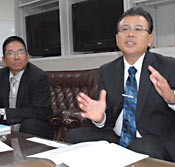
February 10, 2012 Ryukyu Shimpo
On February 8, at a press conference held at the Okinawa Prefectural Government Office, some second-generation Okinawans (ni-sei) who came to Okinawa from Colonia Okinawa, a settlement for Okinawans in Bolivia, requested that the Teacher Dispatch Program to Educational Facilities for Okinawans in Bolivia be continued. As it stands now, the program is scheduled to be discontinued in fiscal 2012.
New Uchina Goodwill Ambassador of the Okinawan Association of Bolivia, Toru Higa, who came to Okinawa to request the continuation of the program, and chairman of the steering committee of the Nueva Esperanza Elementary and Junior High School, Yoichi Inoue, attended. The president of the Bolivian Association in Okinawa, Tetsuo Miyazato, also participated.
They praised the achievements of the teachers dispatched to date, saying that they have taught not only the Japanese language, but also the Okinawan culture and way of thinking. Higa said, “I want to provide a good educational environment for future generations. I hope that everyone comes to know that there are many Uchinanchu living in another Okinawan community in a distant country.” Inoue said, “If the program is abolished we would lose our Japanese language and the spirit of Uchina.”
Higa and others visited the Okinawa Prefectural Office, the Department of Education and the Okinawa Prefectural Assembly and petitioned for the continuation of the program. They will return to Bolivia on February 12.
(English translation by T&CT, Lima Tokumori and Mark Ealey)
Go To Japanese

February 8, 2012 Yukiyo Zaha of the Ryukyu Shimpo
On January 26, a heart-shaped potato was dug up in Yoshio Yonamine’s organic farm in Kochi, Nishihara. The palm-sized potato is seven centimeters by 9.5 centimeters, and weighs 150 grams. It was great timing just before Valentine’s Day. Yonamine smiled as he said, “We might be able to get it displayed beside the chocolate gift counter.”
The variety of potato is called Ryukyu beni-jaga or Ryukyuan red potato, which has red skin, a yellow-colored inside and a naturally sweet taste. Ginoza Village is now striving to produce this potato.
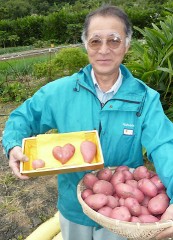
Yoshio Yonamine holding his heart-shaped potato. On January 31 at Kochi, Nishihara.
Yonamine planted 10 kilograms last year and reaped a rich harvest of 153 kilograms. He happened to find the heart-shaped potato when he was digging, and while he was surprised at the find, he felt that this might be an indication that something good is going to happen this year.
Yonamine is also an organic grower who avoids using pesticides and fertilizers, and advocates for such practices on the town council. He said, “I would like to build a production base for farm producers and consumers that is safe for everyone.” Since last July, he has set up a produce stand.
He also offers a place for children to play in a natural environment. Children of the Tabaru Children’s Club came from Naha to paint the stand, and a group called the Play Park Tsuchinoko, which is organized by college students and teachers of an after-school care-program, took children to let them enjoy themselves playing in the mud. Yonamine said, “I think I’ll show this potato to the children.”
(English translation by T&CT, Shinako Oyakawa and Mark Ealey)
Go To Japanese
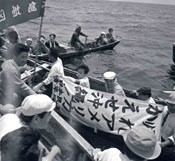
January 31, 2012 Yoshiya Hokama of the Ryukyu Shimpo
The meeting on the sea took place on April 28 in the years between 1963 and 1972. The people of Okinawa, who wished to return to Japanese sovereignty, and the people of Yoron, who had already officially returned to Japan, put fishing boats out and gathered by the maritime border to call for Okinawa’s early return.
With the 40th anniversary this year of the reversion to Japan, Kunigami and Yoron are reenacting the meeting on the sea to look back at the history involved, to pray for lasting peace, and to promote the town and village for further friendship and exchange.
In addition to the meeting, Kunigami sets up a bonfire at Cape Hedo and Yoron does the same at the Reversion Memorial Tower located in the southern part of the town. They also plan a march on Yoron, a relay in Kunigami, and an exchange program for school children.
On January 30, Masao Kawakami the deputy mayor of Yoron and staff of the Tourism and Business department of the town visited the Kunigami Village office. They had their first meeting with Kunigami’s Deputy Mayor Shigeru Kinjo and staff of the Tourism, Business and Planning Department. They coordinated ideas on holding events and will set up a planning committee before the end of February.
Deputy Mayor Kinjo said, “I believe that the mayors’ peace declaration on the sea will strengthen our bonds. I hope that this will be a good public relations activity for us.” Kawakami, the deputy mayor of Yoron, said, “It is marvelous to be able to hold events together. We hope to promote deeper mutual exchanges.”
(English translation by T&CT, Shinako Oyakawa and Mark Ealey)
Go To Japanese
February 6, 2012 Ryukyu Shimpo
Just half a day after the Ryukyu Shimpo newspaper reported the story about the Okinawa Defense Bureau official’s injudicious remark regarding the submission of the Henoko environmental impact report, national papers and news service agencies delivered the story to the world through their own English language news sites. In this Internet age, news is relayed at incredible speed.
On their websites, American media organizations are reporting issues related to the U.S. military bases in Okinawa with increasing frequency, including the matter of the relocation of Futenma. That trend is testimony to the fact that Okinawan affairs have attracted international attention.
Conveying information about the issues of Okinawa through social networking services is also rapidly gaining momentum. Members of the “Making Okinawan Voices Heard in America” delegation, which visited the United States last month, attracted further attention by passing on information of their activities through Facebook on a real-time basis.
The Ryukyu Shimpo newspaper launched an English language news website last May in order to make the current situation in Okinawa better known to the outside world. It is difficult to deliver genuine information to the world via Tokyo about the lot of the Okinawan people, who have been struggling with the excessive burden of U.S. military bases, and the continuous tug of war involving Okinawa and the U.S. and Japanese governments. In that context, they thought why not deliver the information direct from Okinawa? That was the main motivation behind launching the website.
However, it goes without saying that Okinawa has more issues on the table than just U.S. military bases. It needs to let the world know about its performing arts and culture that are unique to Okinawa and the various festivals on each island, plus its rich natural environment. It is also important to pass on information that could promote Okinawan companies that aim to expand their businesses to the Asian economic sphere.
Our ancestors in the Ryukyu Kingdom became engaged in overseas trade and acted as a catalyst among several countries in the spirit of Bankoku Shinryo, the international bridge between countries. Now the issue is how can their descendants play the same role? We think that the international community asks this question of us.
(English translation by T&CT, Mark Ealey)
Go To Japanese
February 7, 2012 Masaaki Umeda of Ryukyu Shimpo
On February 6, with a bilateral air transport agreement having been in place between Japan and Taiwan since November 2011, Far Eastern Air Transport plans to commence a regular charter service between Naha and Kaohsiung once or twice a week in March. The chief executive officer of Far Eastern Air Transport, Zhixing Yan, told Governor Hirokazu Nakaima, who was visiting the company among his official promotion visits to airline companies in Taiwan. The flight will be the first regular charter service between Okinawa and the southern part of Taiwan.
Taiwan’s second largest city, Kaohsiung has a port that handles the sixth largest amount of cargo in the world and its warm climate makes it popular for tourists.
Governor Nakaima said, “Okinawa is prefecture made up of islands, so it covers a vast area and has diverse appeal. I hope that many flights can be introduced to destinations within our prefecture.” Yan responded saying, “We are looking at starting services on other new routes.”
Meanwhile, Mandarin Airlines (MDA) will operate regular charter flights between Naha and Taichung twice a week from April 14 before switching to regular flights in June. TransAsia Airways (TNA) will commence seven flights a week between Naha and Taipei in June. It has also operated charter flights between Ishigaki and Hualian.
At present China Airlines (CAL) runs 11 regular flights a week between Taiwan and Naha, but in the future it is expected that a total of four companies will begin services to and from Okinawa. The number of flights between Okinawa and Taiwan will total over 20 flights a week, and the range of direct flights to and from the central and southern parts of Taiwan will be improved.
On February 6, Governor Nakaima visited companies such as the Taipei branch of the Star Cruises which operates cruise ships, MDA, TNA, the Civil Aeronautics Administration and CAL. Advertising the appeal of sightseeing in Okinawa and its products, the governor requested that Taiwanese companies expand their services and include new routes.
(English translation by T&CT, Lima Tokumori and Mark Ealey)
Go To Japanese
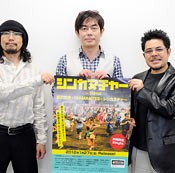
February 7, 2012 Ryukyu Shimpo
On January 27, sales began in Okinawa of an audio CD of Shinkanucha (Fellowship), a song co-created by singer songwriter Kazufumi Miyazawa and the Latin rock band, DIAMANTES. Shinkanucha was the theme song of the 5th Worldwide Uchinanchu Festival held last October and a song for the Worldwide Eisa Festival 2011. The CD consists of six songs, including Shima, a song, which was originally composed by Jake Shimabukuro, then later written by Miyazawa, and performed in the Nipponia concert last October. The price of the CD is 1000 yen.
With regard to the idea behind the song, Alberto Shiroma of DIAMANTES recalls that members of DIAMANTES talked with Miyazawa about Uchinanchu before the Festival. He said, “We wanted to create a song that could turn people’s feelings to the future.”
The song was co-written by Miyazawa, Yoriko Ganeko and Daiichi Hirata. Many musicians, including Claudia Oshiro, participated in the recording of the song. Miyazawa said, “All those people around the world who love Okinawa through music and performing arts are part of Shinkanucha.” With regard to the finale of the festival in which people of Okinawan descent from many different countries came together, Miyazawa said, “I was impressed by the scale of the festival. It was as if their ancestors were also there, visiting their homeland.” Miyazawa said, “I would like it to be used as an eisa song from now.”
For further details, call High Wave at 098 (942) 2777.
(English translation by T&CT, Mark Ealey)
Go To Japanese
February 9, 2012
On February 8, the Japanese and U.S. governments released a joint statement on revisions to the Realignment of U.S. Forces. The two governments agreed to put this in place ahead of the U.S. Marines’ transfer from Okinawa to Guam and separate from the current Futenma relocation plan, and also reaffirmed their adherence to the plan to relocate the Futenma Air Station to Henoko in Nago, describing that as “the only viable way forward.” This is contrary to the opinion of the majority of people in Okinawa and simply falls into line with U.S. policy, so is absolutely unacceptable to us.
In their joint statement, both governments suggested discussing whether or not it is possible to return five facilities and land occupied by the U.S. military south of Kadena Air Base prior to the closure of the Futenma Air Station. Okinawan people struggle to understand why on the one hand Tokyo and Washington seem to have a thought-block on reconsidering the Henoko relocation plan, but on the other they display a flexible attitude to the return of these five facilities. The majority of voters in Okinawa have supported candidates in the Prefectural Governor’s election, national elections, prefectural assembly election and the Nago mayoral election who aligned themselves with the “No Henoko” stance. By ignoring the democratic procedures involved here, the Japanese and United States governments damage the very credibility of democracy.
The citizens of Okinawa seek the relocation of Futenma’s facilities either outside the prefecture or overseas or the unconditional return of the land used by Futenma Air Station. While the heads of the municipalities and residents welcome the “progress” in the revised plan that an earlier return of facilities and land can be expected, people have reacted with dismay at the prospect of the facilities at Futenma – described as “the world’s most dangerous airbase” – remaining there on a permanent basis. The Okinawan people are sensitive towards the suffering of others; this is part of our approach to life. Okinawa is neither a colony of Japan nor of the United States – it is not somewhere that they can do whatever they like. If MV-22 Osprey vertical takeoff and landing aircraft that have defects are deployed to Futenma Air Station, this would be a possible threat to human life and human rights. The citizens of Okinawa are not so innocent and gullible as to take this situation lying down.
More than 60 years ago, John Foster Dulles requested that Japan grant the United States the right to maintain military forces in Japan at whatever levels, locations and term America saw fit. As the special envoy of the U.S. President he negotiated with Japan on the Japan-U.S. Security Treaty and the Treaty of San Francisco. Since those days, Japan has continued to follow the United States in its foreign policy. Does this country have a distorted security policy that allows U.S. forces to use bases freely and to treat human rights or people’s lives as though they are of secondary importance?
In response to questions in the Diet, Prime Minister Yoshihiko Noda answered, “The government’s intention to relocate the U.S. Marine Corps Futenma Air Station to Henoko in Nago remains unchanged.” We cannot understand the logic of sticking to the Henoko plan when even prominent people in the United States have raised questions about the military and political rationality of the situation. We would like Prime Minister to respect the human rights and lives of Okinawans to the same extent as those of the people of the main islands of Japan. If he genuinely wishes to have a sustainable relationship with the United States, he will respect the will of the people and strive to convince President Obama to abandon the Henoko plan and remove Futenma Air Station from Okinawa.
(English translation by T&CT, Mark Ealey)
Go To Japanese












 Webcam(Kokusai Street)
Webcam(Kokusai Street)


